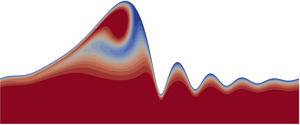Published online by Cambridge University Press: 04 September 2020

The paper presents results of numerical simulations of a dissolved substance diffusing out of a liquid film in a two-dimensional, gravity-driven laminar flow down a vertical solid plane. The fluid mechanic problem is solved separately subject to periodicity conditions in the flow direction. After steady-state is reached, up to a hundred copies of the calculated wave and associated flow fields are efficiently ‘glued’ together to generate a long computational domain for the diffusion process which is solved as an initial-value problem. This approach renders it possible to follow the diffusion process over a long distance and to elucidate its various stages. It is found that large and small waves, with a maximum liquid velocity larger or smaller than the wave speed, respectively, behave differently. For the latter, the Sherwood number reaches an asymptotic value by the time the film still contains a significant amount of solute. From this point on, the mass transfer is very similar to that of a flat film with a smaller thickness (quantified in this paper). For large waves, the contributions of the various parts of the wave – main crest, capillary waves, nearly flat substrate – evolve differently with time and conditions and may negatively affect the mass transfer process if they get out of balance. Thus, the presence of recirculation is, in and by itself, insufficient to judge the mass transfer performance of a falling film.